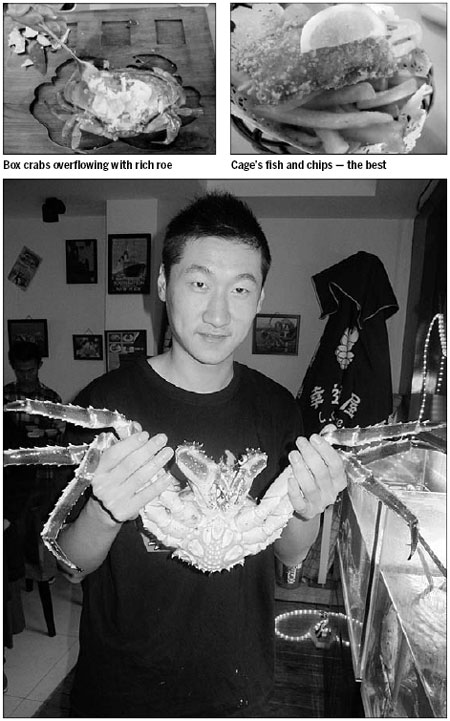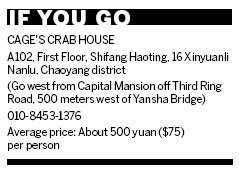Come eat crabs
By Pauline D Loh (China Daily)
Updated: 2010-12-13 09:24
 |
Large Medium Small |


Beijing
Beijing is not known for its fresh seafood, but tucked away off the main road near Yansha Bridge, a crab feast waits. Pauline D Loh takes a crack at the banquet.
When they say crabs, they mean crabs. None of your puny local river crabs here, and we are certainly not even talking about common mud crabs or blue swimmers.
Cage's Crab House offers serious crustaceans for the dinner table - huge arm-span sized Alaskan king crabs, 2-kg Tasmanian mottled snow crabs, US West Coast Dungeness crabs, and something the staff recommended as "bread crabs".
Of course, the size of the critters is directly commensurate with the magnitude of the bill, but for an occasional treat, nothing beats a good crab feed to satiate that seafood longing.
As soon as you push open the door, you stumble upon a double aquarium displaying the crabs. Most diners will stop and gape.
It is an impressive display, with the Alaskan kings dominating the tanks with their giant legs splayed in aggressive display against the snow crabs. The Dungeness crabs huddle behind the water filters and bread crabs pretend to be fossilized lumps at the bottom of the tanks.
Bread crabs? That's what the enthusiastic waiters say they are called. Further queries unearthed the scientific name - Calappa philargius. Whatever the name, they are a gourmet crab-eater's dream come true.
These creatures are actually known as box crabs, and they inhabit the coastal seas from the equatorial flats of Indonesia to the freezing shores of the North Sea.
Here at Cage's Crab House, box or bread crab is served in a set meal that includes salad, soup, and a little basket of fish and chips that is arguably the best in Beijing. It even comes with malt vinegar.
The crab itself is steamed and regally presented on a specially made platter with "Cage's Crab House" emblazoned on it, together with a pile of napkins and a wooden mallet.
Our waiter took pains to explain how we should go about eating our box crab. Place the napkins on top of the shell and go at it with the mallet. Once the brittle shell has cracked into pieces the roe is exposed. And what vast amounts of roe!
It seems that the box crab probably devotes its entire existence to reproduction and in season, the crab is all roe and very little meat - and it's fully 25cm across. The roe itself is surprisingly delicate, and remains quite creamy, unlike the hard sandy clumps you often find in other crabs.
A little tub of lemon butter comes with the crab to help it on its finger-lickin' way.
We also ordered the snow crab, which is eaten for its meat, and which is noticeably sweeter.
The Alaskan king crab also comes in a set meal for four to five diners, and the whole meal includes one huge steamed crustacean, individual salads, soups, a bread basket, crab cakes, fish and chips and ginger tea.
That's the local touch to a very Western way of eating crabs. The Chinese believes crab is a cooling food, too much of which will tamper with the yin yang balance of the body. To counter that, a hot mug of ginger-infused tea with dark brown sugar does the trick.
My colleague asked a pertinent question which solicited a laughing response.
Why is the restaurant called Cage's Crab House? Well, apparently the mistress of the restaurant is a fervent fan of actor Nicolas Cage, whose likeness is plastered all over the walls of the restaurant, in-between photographs of famous crabs of the world.
It says much of Beijing's culinary sophistication that you can now find a crab house here that looks as if it was transported straight from Fishermen's Wharf in San Francisco. The service is friendly, the atmosphere is cozy and you get fresh crabs to eat that were staring at you out of a tank just moments ago.
If the price tag is a little steep, well, what do you expect? Someone has to pay for the air tickets.